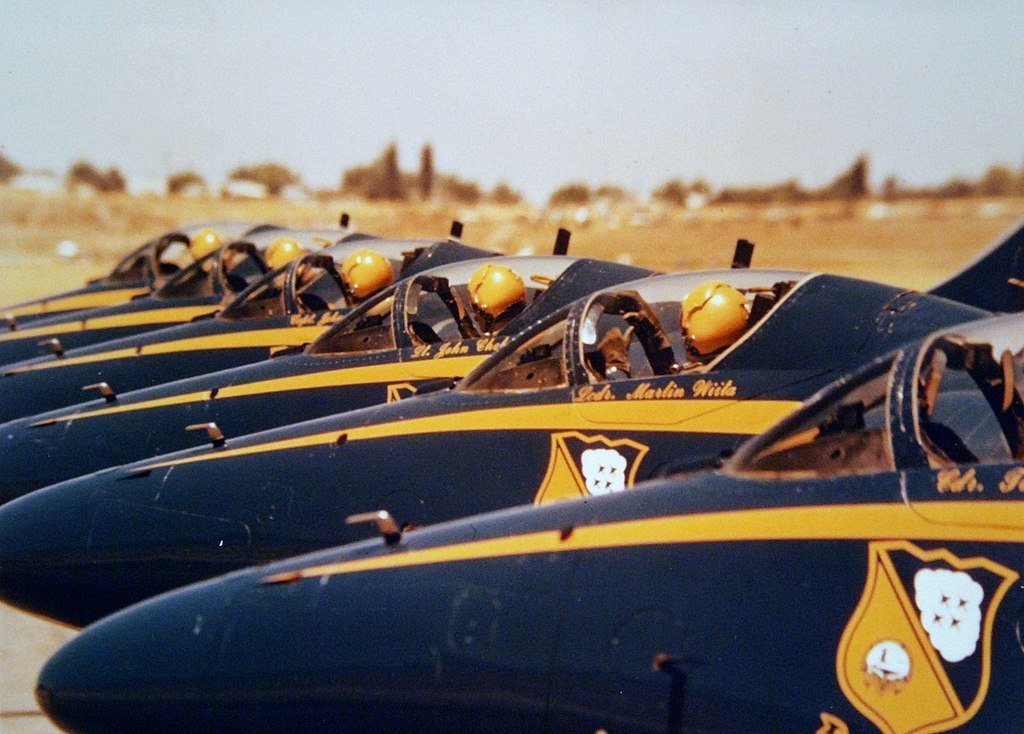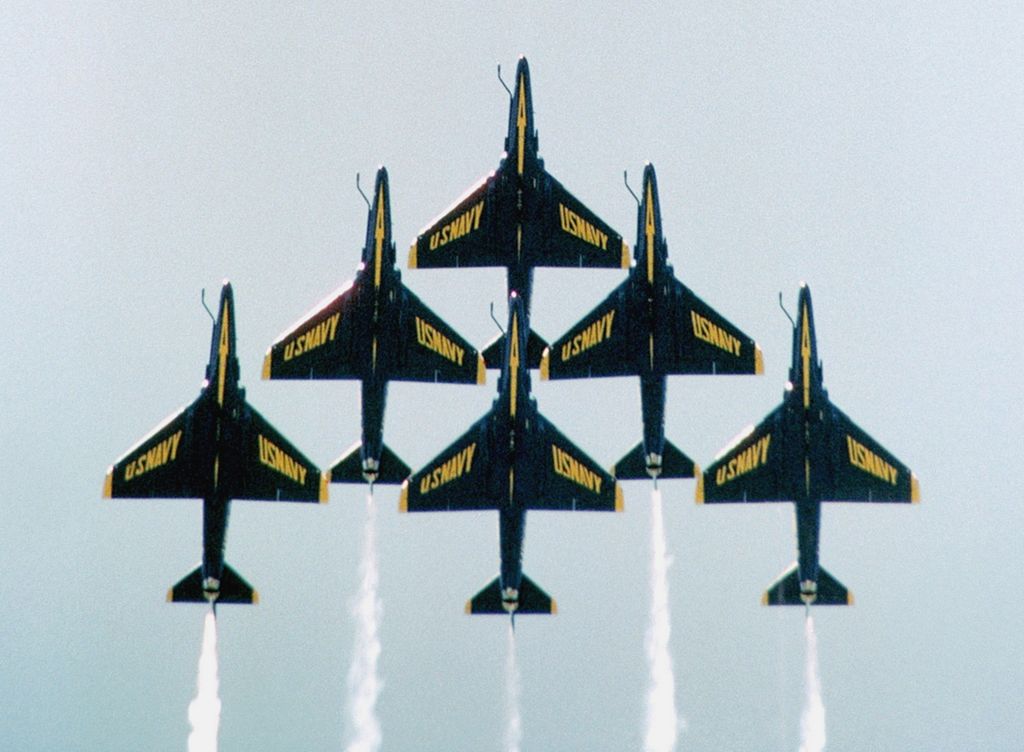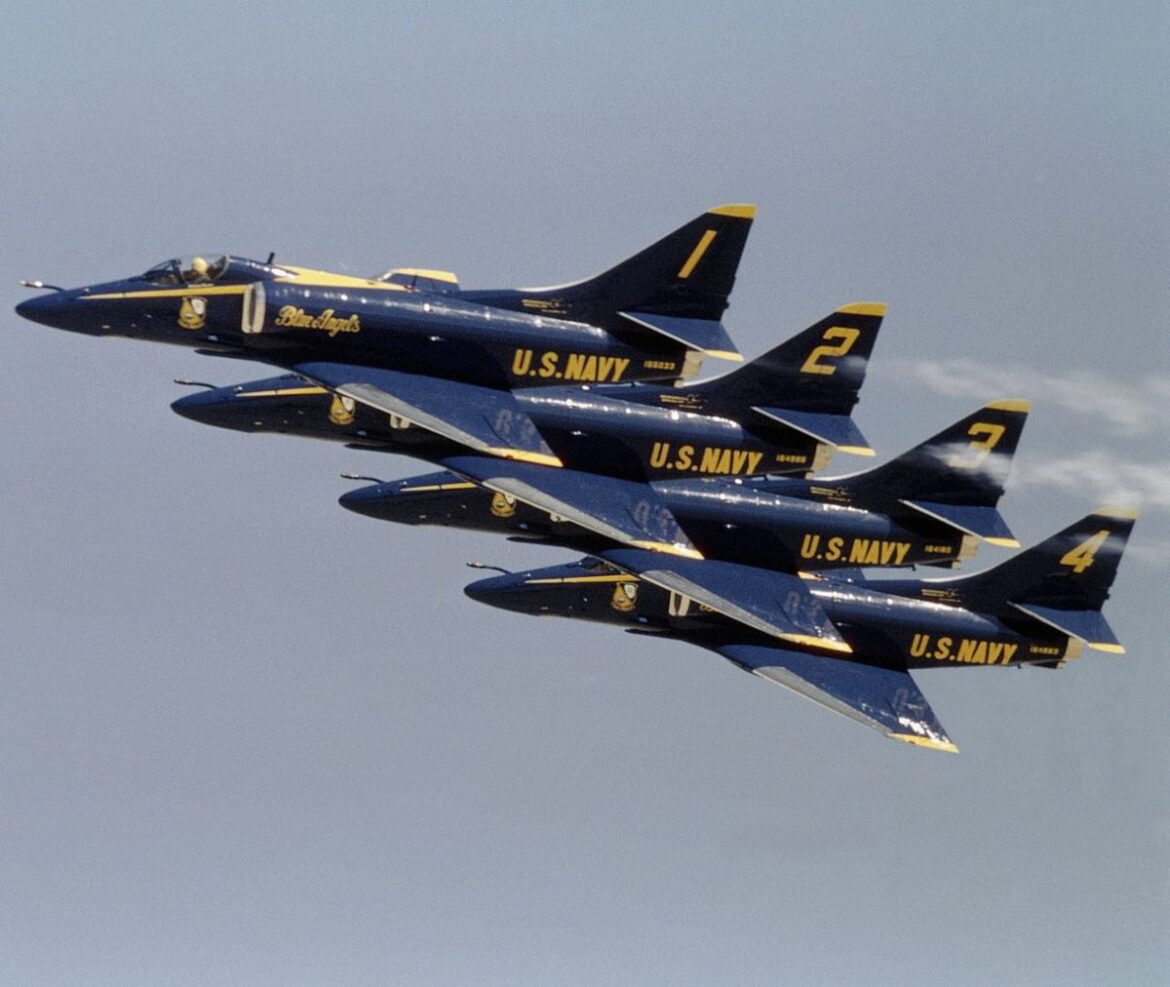‘While we were doing this search for airplanes, a couple of squadrons were coming back from Vietnam and were being decommissioned. They had the A-4F, which was the latest model at that time,’ Ken Wallace former Blue Angels CO
The lightweight, high-speed A-4 Skyhawk gave the US Navy, Marines, and friendly nations a maneuverable yet powerful attack bomber with great altitude and range capabilities and unusual flexibility in armament capacity. It was built small to be cost-effective and to fit more of them on a carrier.
Between 1956 and 1979, around 3,000 A-4s were built; they were used as aggressor aircraft, as front-line squadrons, and as advanced trainers (the latter being called TA-4s and having two-seat cockpits). The Navy Flight Demonstration Squadron’s Blue Angels were also equipped with A-4s.
Following a series of accidents and maintenance issues with their McDonnell Douglas F-4J Phantom IIs during the 1973 air show season, the Blue Angels stood down to allow Secretary of the Navy John Warner—who would go on to serve six terms in the US Senate as a representative of the state of Virginia—to give a program overview. Six senior flag officers were assigned by Warner to examine the Blue Angels program, and they all agreed that it should be continued as a “prime recruiting asset.”

According to Nicholas A. Veronico’s narrative in The Blue Angels a Fly-By History, Ken Wallace, a team leader in 1961–1963 and slot pilot in 1954–1955, was asked to lead the team through challenging times. Wallace was the tactical air plan officer in the chief of naval operations’ office. “Because of my past association with the Blue Angels, whenever anything that concerned them came up, I was rung in on it in some way,’ he said.
According to Wallace, “the Secretary of the Navy was not fully supportive of keeping the team. Admiral Zumwalt, who was chief of naval operations and not an aviator, was very much insistent on keeping the team in business. So he and I went to chat with the Secretary of the Navy. The Secretary agreed to keep it in business, but we had to change airplanes. He would not let us continue with the F-4s, partially due to the crashes, and at this point, we were in the fuel crunch of the mid-1970s. The F-4 is not an economical airplane on fuel, and it is a heavy-maintenance airplane. It was just a little bit too visible for the times.”
Given the job of program manager for the Blue Angels, Wallace had his work cut out for him. Drawing on his previous experience with the team, he would implement many far-reaching changes. “I started casting about for a different airplane. The airplane that I really wanted was the F-14,’ he said. “I did not want an F-14 with all the weapons control systems in it; that was wasteful.” After proposing his idea to Grumman, they decided that it would cost more to make an airplane without the systems than it would to make one with them. Cost became the determining factor, and the F-14 idea went by the wayside.
For Wallace, the A-7 was the next logical choice. He said, “There simply were not enough airplanes in the pipeline to let us have them. The fleet needed the A-7 desperately and could not divert seven aircraft for our use. I went down to Chance Vought and flew the airplane, and it certainly would have been quite suitable.”

Although it had been looked at by many team leaders in the past, Wallace once again considered McDonnell Douglas’ A-4 Skyhawk. “The A-4 was about the only fleet airplane left that was anywhere near usable by the team,” he said. “It just so happened that while we were doing this search for airplanes, a couple of squadrons were coming back from Vietnam and were being decommissioned. They had the A-4F, which was the latest model at that time. They also had the latest engine, the P-408. It had more thrust than any of the previous engines the A-4 had used.
“We got together with the engineers at McDonnell Douglas and with some of the people at Naval Air Systems Command. We needed some changes to the control system. We needed more nose-down force. Traditionally, the Blue Angels fly the airplane, regardless of the model, with a full-down nose trim. It gives us, in some cases, 40 pounds of nose-down stick force. We want that nose-down force, so we’ve got something we are putting pressure against all the time. Plus, in rough air, it tends to make you bounce away from the formation rather than up into the airplanes ahead of you. By bracing our right forearm on our leg or knee, it provides a very stable or firm base to control the airplane with the stick. By just flexing your wrist a little bit, rather than having large-magnitude arm movements, you get your control that way. The engineers at McDonnell Douglas came up with a bungee cord arrangement that modified the bell crank assemblies in the airplane, thus providing the nose down force.
“We also bolted up the leading-edge slats. The A-4 in its normal configuration has aerodynamic slats on the leading edges of the wings. They are actuated by aerodynamic force and are used in heavy g-loads or accelerations. They increase the camber of the wing so that you get more lift. The problem with those aerodynamic slats is that depending on the condition of flight, if you’re not exactly in balanced flight or if you are in a turn, one slat may not come out and the other may fully deploy. It really depends on the air loads. If they come out asymmetrically, they can pop you right on your back faster than you can think about it. We determined that by bolting them up we would not add to the landing speed of the airplane by any significant amount.

“We took the guns out, some armor plating, added a drag chute for operations from shorter airports, and added weight to the nose for balance. The overall weight reduction was significant. We ended up with an airplane that weighed 11,300 pounds [dry] and we had an engine that produced 11,400 pounds of thrust. When you got down to a light fuel load, you could do some pretty cute tricks with that little airplane. The roll rate would certainly not spin your head, but it was more than enough for what we wanted to do in the air show.’
The ultimate modification saw the Blue Angels elevated to the rank of a full U.S. Navy squadron, endowing the team commander with the same power and position as a squadron CO. This meant that the flight surgeon, supply and administrative officers, and the public affairs and maintenance teams were no longer loaned to the team.
The Skyhawk made its show season debut in 1974 and flew with the Blue Angels until 1986, when the McDonnell Douglas F/A-18 Hornet took its place.
Photo by U.S. Navy

